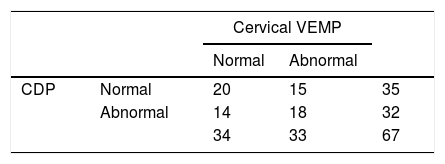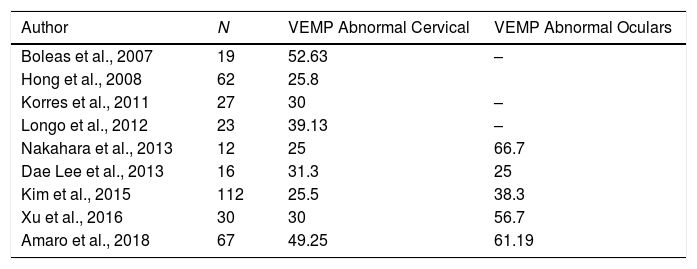Benign paroxysmal positional vertigo (BPPV) pathophysiology is based on otoconia migration from the utricle and saccule to the semicircular canals, however, the role of the saccule is still under study. Our aim is to study the otolith damage in these patients with vestibular evoked myogenic potentials (VEMPS) and correlate the results with those of computerised dynamic posturography (CDP).
Material and MethodsWe present 79 patients diagnosed with BPPV between March and June 2017. VEMPS and CDP studies were performed. We selected 67 patients with posterior semi-circular canal BPPV and we compared them with 60 healthy subjects.
ResultsBPPV group had abnormal cervical VEMPS in 49.25% of patients compared to 16.67% in the control group. Ocular VEMPS were altered in 61.19% of the patients and 6.67% of the healthy subjects. Abnormal ocular VEMPS in patients with recurrent BPPV was statistically significant. There was no significant correlation with CDP results.
ConclusionsUtricular and saccular dysfunction in BPPV patients proved by VEMPS is higher than in healthy individuals. This result may be related to symptoms of instability experienced by these patients occasionally.
La fisiopatología del vértigo posicional paroxístico benigno (VPPB) se explica por la migración de otoconias de la mácula del utrículo a los canales semicirculares; no obstante, el papel del sáculo en esta entidad continúa en estudio. Nuestro objetivo es estudiar el daño otolítico en estos pacientes con potenciales vestibulares miogénicos evocados (VEMP) y relacionarlo con los resultados de la posturografía dinámica computarizada (PDC).
Material y métodosPresentamos 79 pacientes diagnosticados de VPPB de manera consecutiva entre marzo y junio de 2017 a quienes se les realizó un estudio con VEMP oculares y cervicales y PDC. Seleccionamos los 67 pacientes con VPPB del canal semicircular posterior y los comparamos con un grupo control de 60 pacientes.
ResultadosLos pacientes con VPPB presentaron VEMP cervicales alterados en el 49,25% de los casos, frente al 16,67% en el grupo control. La alteración en VEMP oculares fue del 61,19% en el grupo de VPPB, frente al 6,67% en el grupo control. La prevalencia de VEMP oculares anormales en pacientes con VPPB recurrentes fue estadísticamente significativa. No se halló correlación significativa con los resultados alterados de la PDC.
ConclusionesLa disfunción sacular y utricular en los pacientes con VPPB medida mediante VEMP es mayor que en la población sana. Esta alteración puede estar relacionada con la inestabilidad residual que a veces experimentan estos pacientes.










